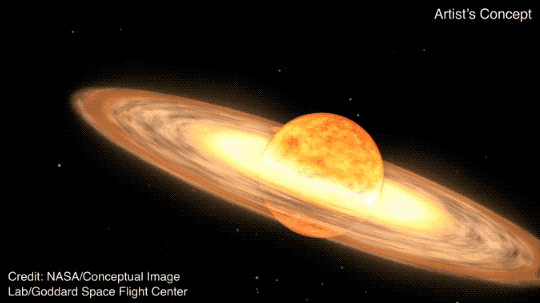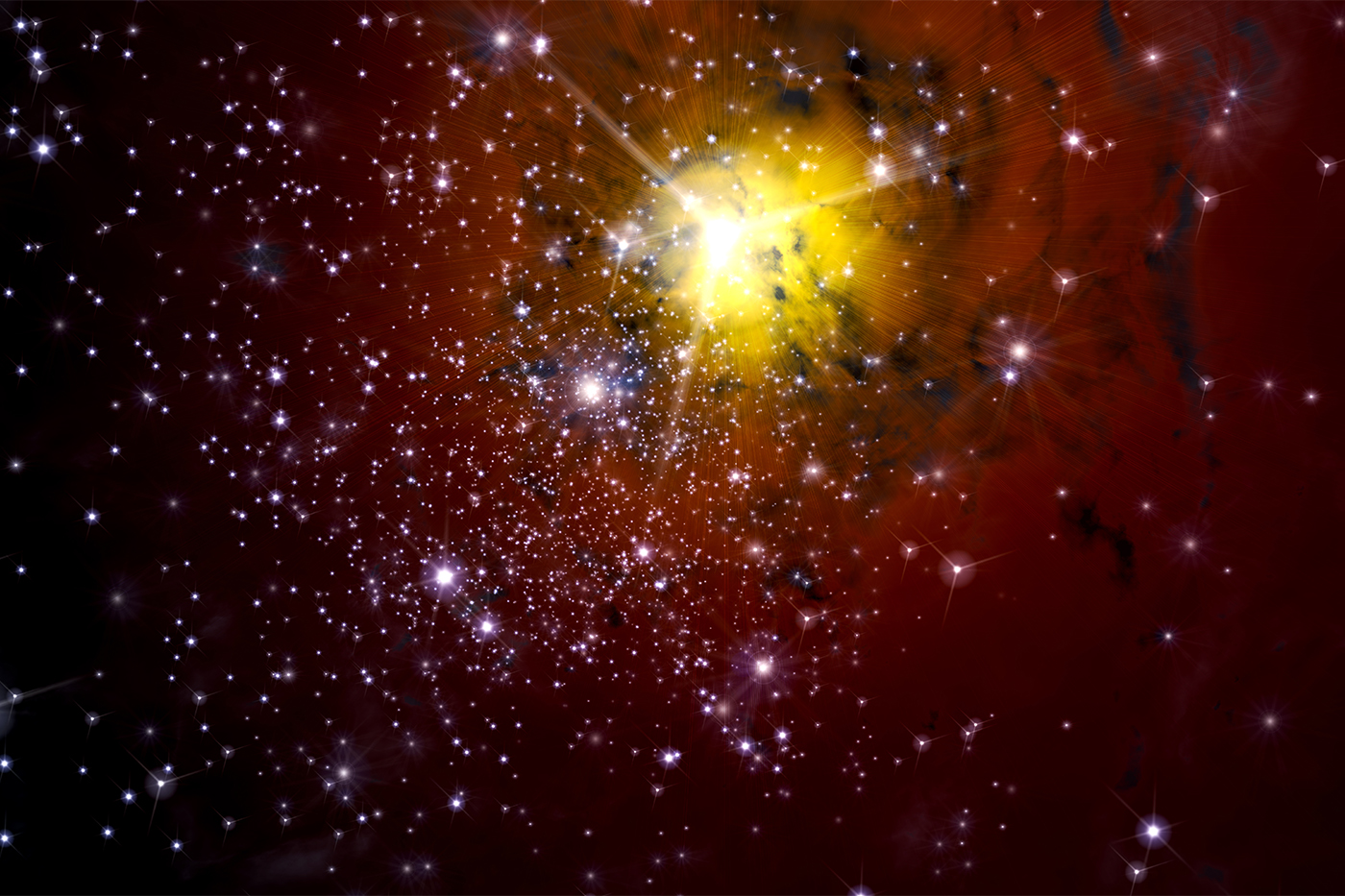
In an artist’s rendering, a red giant star and white dwarf star circle each other. Material ejected from the red giant gathers and heats in the white dwarf, catalyzing a bright explosion. NASA’s Goddard Space Flight Center
At some point during the next several months, a distant, dead star will rapidly grow brighter in a powerful explosion, making it visible from Earth for a short period of time. To observers on the ground, it will look like a new star.
The dead star—which is currently not bright enough to appear in the sky—is one of a pair that orbit each other in a binary system called T Coronae Borealis, or T CrB. Known as a white dwarf, this leftover stellar core is snatching material from its neighboring red giant. When it gathers enough, roughly every 80 years or so, the white dwarf releases energy in a bright outburst, according to NASA.

Astronomers excitedly await the short-lived event. “When T CrB goes off, a large fraction of every telescope in the world is going to be pointed at it,” Bradley Schaefer, an astrophysicist at Louisiana State University, tells Scientific American’s Robin George Andrews.
T CrB is located 3,000 light-years from Earth. The astronomer John Birmingham observed its outburst from western Ireland two explosions ago, in 1866, according to Nicole Mortillaro of the Canadian Broadcasting Corporation (CBC). Then, it flared up again in 1946. There’s also evidence that it was seen in 1787 and 1217, per the New York Times’ Robin George Andrews.
Such an event is called a nova—a rapid increase in the brightness of a white dwarf that reignites after years of slumber. These outbursts are different than supernovae, which are much more dramatic. Supernovae occur when a dying star erupts in a release of energy that can briefly outshine galaxies.
In systems like T CrB, a white dwarf is locked in a dance with a red giant, a star that has run out of fuel and begun to die. The red giant swells in size, its temperature and pressure increasing, and starts to eject its outer layers. A lot of this material is hydrogen gas, which gets slurped up by the white dwarf. Eventually, the white dwarf grows hot enough on its surface—a temperature of about 10 million Kelvin—to produce a nuclear explosion.
How to see the nova explosion
/https://tf-cmsv2-smithsonianmag-media.s3.amazonaws.com/filer_public/2f/f3/2ff324f4-b924-41ed-a42b-f3ff90fef31c/findhercules_nsn896.webp)
The nova will appear in the constellation Corona Borealis, located between Hercules and Boötes. NASAThe T CrB white dwarf is usually too dim to see from Earth with the naked eye. But at the peak of its explosion, it will appear as bright as North Star. You won’t need any special equipment to see it.
“T Cor Bor goes from its lowest level, which it’s just trundling along at right now, to its peak [in about] three hours or something like that—it’s really fast,” Schaefer tells the CBC.
The bright blast will appear in the constellation Corona Borealis, a small, semicircular arc between the constellations Hercules and Boötes. If you want to witness the event yourself, NASA advises becoming familiar with Corona Borealis before the fleeting explosion.
You should be able to see T CrB with the naked eye for several days and with binoculars for just over a week, according to NASA.
When will the nova occur?
Astronomers don’t have an exact time for when the blast will go off, but they’re refining their guesses based on the behavior of T CrB’s last nova.
“We know from the last eruption back in 1946 that the star will get dimmer for just over a year before rapidly increasing in brightness,” William J. Cooke, the lead for the NASA Meteoroid Environments Office, tells CNN’s Ashley Strickland. “T Coronae Borealis began to dim in March of last year, so some researchers are expecting it to go nova between now and September.”
“We’ve been following it worldwide, and it’s been doing some fun things,” Sumner Starrfield, an astrophysicist at Arizona State University, tells National Geographic. “It got brighter for a few years and now has faded a bit. It seems to be doing pretty much the same thing it did just before it exploded in 1946, which is why we’re suddenly very interested.”
When the light from the explosion does appear in Earth’s skies, it will be a rare moment in astronomy. T CrB is one of just ten recurring novae in the Milky Way galaxy, Cooke tells CNN.
“The fact that it’s recurring on a timescale we could work with, as far as humans are concerned… makes it very special,” Paul Delaney, an astronomer at York University in Canada, says to the CBC.
“It’s a once-in-a-lifetime occurrence,” Cooke tells the New York Times. “How often can people say that they’ve seen a star explode?”
News
Breaking News: Jon Voight and Angelina Jolie Join Forces to Launch Traditional Values-Focused Production Studio—What Inspired This Unexpected Collaboration, and How Will It Impact Hollywood’s Narrative Landscape?
In a noteworthy development, renowned Hollywood figures Jon Voight and Angelina Jolie have teamed up to launch a new production studio dedicated to upholding traditional values and moving away from contemporary woke ideologies. This initiative arises as dissatisfaction mounts within…
Elon Musk Confronts Beyoncé, Demanding She Cease Singing Country Music or Face Consequences—What Prompted This Clash Between Two Iconic Figures, and What Could the Ramifications Be?
In a surprising turn of events, tech entrepreneur Elon Musk and music icon Beyoncé have found themselves at odds over artistic expression and genre boundaries. The clash unfolded publicly after Beyoncé launched her new country album titled “Cowboy Carter,” which…
Daniel Radcliffe Addresses Potential Role in New Harry Potter TV Series Reboot Amidst JK Rowling Feud—What’s His Stance, and How Might This Impact the Franchise’s Legacy?
Published 12:55 23 May 2024 GMT+1 Daniel Radcliffe has spoken about his future in the Harry Potter TV shows amid his ongoing feud with creator JK Rowling The Boy Who Lived is seemingly keeping his spell book shut when it comes…
Taylor Swift Faces NFL Ban: What Led to This Decision, and How Will It Impact Her Relationship with the League?
In a stunning announcement that has taken both the music and sports worlds by storm, Taylor Swift has been banned from attending all future NFL games. The decision, reportedly made by NFL officials, cites the pop superstar’s presence as “too…
Breaking News: Bud Light Announces Closure of Locations Amid Boycott—What Prompted This Decision, and What Does It Mean for the Future of the Company and the Boycott Movement?
A Strategic Contraction Amid Crisis: Bud Light Announces Closure of Multiple. The ripple effects of Bud Light’s recent marketing missteps continue to impact the brand, with the beer giant now announcing the closure of multiple locations. This decision marks another…
Taylor Swift’s Astonishing Four Surprises for Travis Kelce at her 87th Concert: What Were They, and How Did They Strengthen Their Love?
There is evidence of Travis Kelce everywhere you look Taylor Swift‘s Eras Tour has been evolving as it has made its way around the world, and the European leg perhaps features more references to her romance with Travis Kelce than ever before….
End of content
No more pages to load











